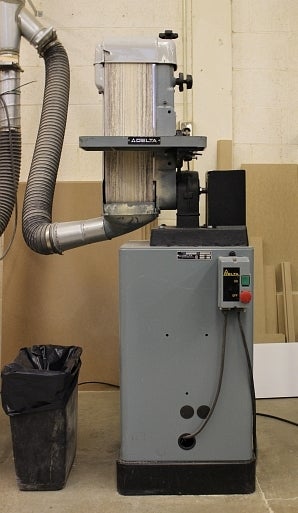Description and uses
See disc sander description and uses for complementary information.
The belt sander is similar in function to the disc sander, and as such, is useful for truing the ends of lumber, chamfering, etc. It is less aggressive than the disc sander and is not limited to any particular position on the bed. The bed and the mitre gauge function exactly like they do with the disc sander. In addition, the belt has a longer sanding surface, enabling you to sand along the length of some shorter pieces (up to 12 inches long).
Basic sanding
Stand in a stable position and hold your material firmly on the sander's bed with both hands. Longer pieces may need to be supported by a work support. Push the material gently into the sanding belt, making sure to keep your hands away from the abrasive surface. Always make sure that the material is held firmly on the bed to prevent it from kicking up.
Further considerations
- Make sure that the belt is not torn or loose
- Never work with loose gloves or hold material with a rag when sanding.
- Ensure that the bed is clear of materials, tools, and debris.
- The belt tracking mechanism needs frequent readjustment If the belt starts to migrate, shut off the machine and inform the shop technician immediately.
Tip
Sand slowly, periodically checking for measurements and alignment.
Cautions
- Eye protection is mandatory
- Ear protection is required for prolonged use.
- A dust mask is recommended for plywood and particleboard and required for MDF and certain toxic woods
- Only operators trained in the safe operation of a disc sander are allowed to use it.
- Never start the machine with the abrasive belt touching the workpiece
Belt sander
